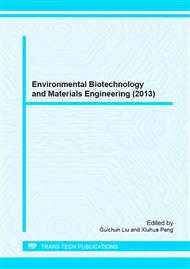[1]
I.F. Cheng, R. Muftikian, Q. Fernando, N. Korte, Reduction of nitrate to ammonia by zero-valent iron, Chemosphere. 35 (1997) 2689-2695.
DOI: 10.1016/s0045-6535(97)00275-0
Google Scholar
[2]
C.P. Huang, H.W. Wang, P.C. Chiu, Nitrate reduction by metallic iron, Water Res. 32 (1998) 2257-2264.
DOI: 10.1016/s0043-1354(97)00464-8
Google Scholar
[3]
Y.H. Hwang, D.G. Kim, Y.T. Ahn, C.M. Moon, H.S. Shin, Fate of nitrogen species in nitrate reduction by nanoscale zero valent iron and characterization of the reaction kinetics, Water Sci. Technol. 61 (2010) 705-712.
DOI: 10.2166/wst.2010.895
Google Scholar
[4]
Y.H. Hwang, D.G. Kim, H.S. Shin, Mechanism study of nitrate reduction by nano zero valent iron, J. Hazard. Mater. 185 (2011) 1513-1521.
DOI: 10.1016/j.jhazmat.2010.10.078
Google Scholar
[5]
Z. Jiang, L. Lv, W. Zhang, Q. Du, B. Pan, L. Yang, Q. Zhang, Nitrate reduction using nanosized zero-valent iron supported by polystyrene resins: role of surface functional groups, Water Res. 45 (2011) 2191-2198.
DOI: 10.1016/j.watres.2011.01.005
Google Scholar
[6]
H. Park, Y.M. Park, K.M. Yoo, S.H. Lee, Reduction of nitrate by resin-supported nanoscale zero-valent iron, Water Sci. Technol. 59 (2009) 2153-2157.
DOI: 10.2166/wst.2009.243
Google Scholar
[7]
G.C. Yang, H.L. Lee, Chemical reduction of nitrate by nanosized iron: kinetics and pathways, Water Res. 39 (2005) 884-894.
DOI: 10.1016/j.watres.2004.11.030
Google Scholar
[8]
X. Fan, X. Guan, J. Ma, H. Ai, Kinetics and corrosion products of aqueous nitrate reduction by iron powder without reaction conditions control, J. Environ. Sci. (China). 21 (2009) 1028-1035.
DOI: 10.1016/s1001-0742(08)62378-5
Google Scholar
[9]
M. Kumar, S. Chakraborty, Chemical denitrification of water by zero-valent magnesium powder, J. Hazard. Mater. 135 (2006) 112-121.
DOI: 10.1016/j.jhazmat.2005.11.031
Google Scholar
[10]
A. Olad, F. Farshi, J. Ettehadi, Electrocatalytic reduction of nitrate ions from water using polyaniline nanofibers modified gold electrode, Water Environ. Res. 84 (2012) 144-149.
DOI: 10.2175/106143011x13225991083604
Google Scholar
[11]
J. Warna, I. Turunen, T. Salmi, T. Maunula, Kinetics of nitrate reduction in monolith reactor, Chem. Eng. Sci. 49 (1994) 5763-5773.
DOI: 10.1016/0009-2509(94)00331-9
Google Scholar
[12]
C.J. Ottley, W. Davison, W.M. Edmunds, Chemical catalysis of nitrate reduction by iron(II), Geochi. Cosmochi. Acta. 61 (1997) 1819-1828.
DOI: 10.1016/s0016-7037(97)00058-6
Google Scholar
[13]
S.H. Choe, Y.Y. Chang, K.Y. Hwang, J.H. Khim, Kinetics of reductive denitrification by nanoscale zero-valent iron, Chemosphere. 41 (2000) 1307-1311.
DOI: 10.1016/s0045-6535(99)00506-8
Google Scholar
[14]
H. Wei, S.P. Tong, H.Y. Wang, et al, Rapid treatment of atrazine-contaminated water by nickel bimetallic system, J. Environ. Sci. 16 (2004) 925-927.
Google Scholar
[15]
H.Y. Zhou, J. Han, S.A. Baig, et al, Dechlorination of 2, 4-dichlorophenoxyacetic acid by sodium carboxymethyl cellulose-stabilized Pd/Fe nanoparticles, J. Hazard Mater. 198 (2011) 7-12.
DOI: 10.1016/j.jhazmat.2011.10.002
Google Scholar
[16]
H.Y. Hu, N. Goto, K. Fujie, Effect of pH on the reduction of nitrite by metallic iron, Water Res. 35(2001)2789-2793.
DOI: 10.1016/s0043-1354(00)00570-4
Google Scholar


